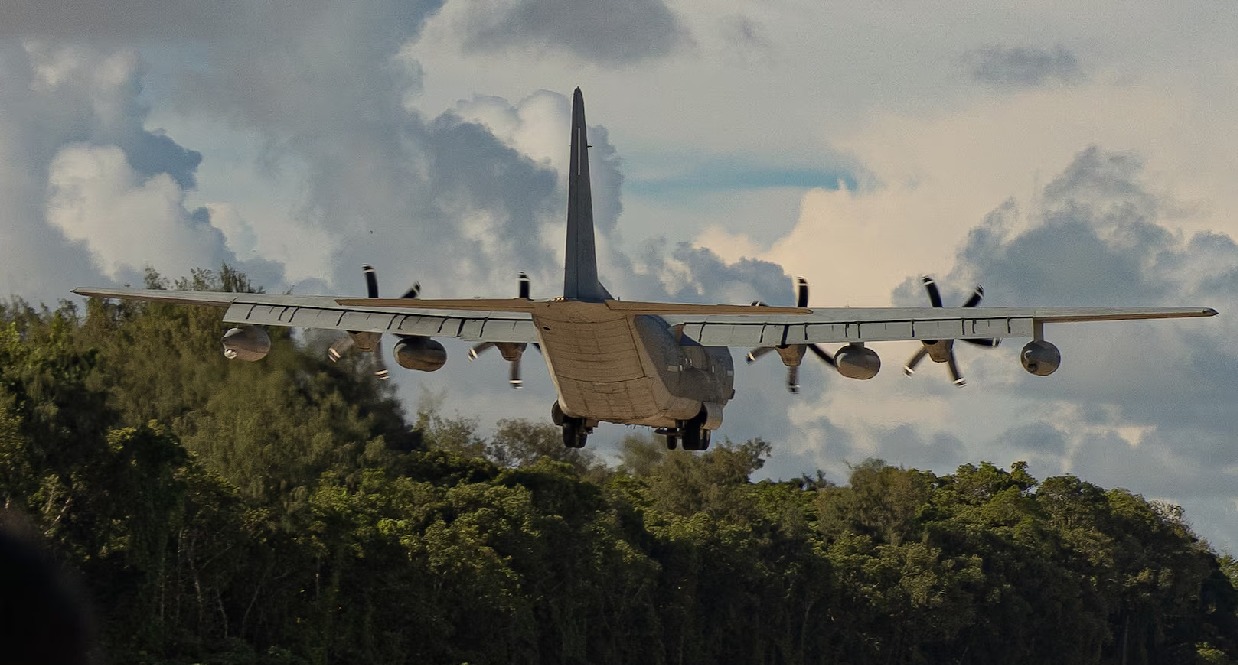US Military Aircraft Makes ‘Historic Landing’ At Iconic WWII Airstrip; Could Play A Key Role In War With China

A US Marine Corps fixed-wing aircraft landed at the historic Peleliu airstrip for the first time after the former World War-2 era Japanese airfield was revived for use by the US military.
The US Pacific Command (PACOM) said: “For the first time since its recertification in June, a military fixed-wing aircraft has touched down on the historic Peleliu airstrip, marking a significant and triumphant return to this iconic World War II site on June 22, 2024.”
The aircraft that touched down on the airstrip was a US Marine Corps (USMC) KJ-130J tanker aircraft, the primary aerial refueling aircraft for Marine fixed-wing jets and helicopters. The plane can perform medical evacuation or medevac operations, drop ground forces, provide a Direct Air Support Center, and resupply harsh combat zones.
PACOM further stated in its release that the engineers of the 7th Engineer Support Battalion, 1st Marine Logistics Group, and the Marine Corps Engineer Detachment Palau (MCED-P) 24.1 put countless hours of work to make the historic occasion possible.
AfriPrime App link: FREE to download...
https://www.amazon.com/Africircle-AfriPrime/dp/B0D2M3F2JT
With the lingering Chinese threat, the US had been trying to restore and upgrade this Pacific airstrip. The airstrip could play a significant role in a potential conflict with China in the Indo-Pacific.
Without naming a specific country, the PACOM said, “The MCED-P has been diligently rehabilitating the WWII-era Japanese airfield on Peleliu, a mission-critical to enhancing U.S. military strategic capabilities in the Indo-Pacific region. The successful landing marks the culmination of months of dedicated work by the Marine engineers.”
Peleliu is one of the many locations in the Pacific where the US has been trying to expand its presence and modernize infrastructure for use during a contingency. In addition to Peleliu, the US has rehabilitated previously abandoned locations, stationed more advanced fighters in Japan, and is bolstering the military’s presence on Guam, which is expected to be a launchpad for its troops.
Peleliu is an island in the Pacific state of Palau that remains opposed to China and is one of the few countries that recognize Taiwan. With Beijing making swift inroads into the Pacific region, as evidenced by its security pact with the Solomon Islands, the US has moved in to secure its place.
With its strategic location in the Pacific and its stiff opposition to China, Palau figured highly on the list, especially since the US had already forged a defense partnership with the small island state. For instance, the Army resumed training in Palau following a 37-year pause in 2019. During an exercise the next year, a Patriot missile battery stationed there took down a target drone.
However, the revival of an airstrip has taken that partnership up a notch. The US Department of Defense (DoD) representatives met with leaders and citizens of the Republic of Palau on May 13–15 to discuss the proposed facility on the island of Peleliu. Palauans were presented with the proposal’s specifics — including plans to enlarge and restore the Peleliu Airstrip and South Dock — by the Navy, Air Force, and Marine Corps engineers.
Although Peleliu still needs more work before the project is finished, the airstrip’s recertification is a significant step toward the site’s restoration. And, with an aircraft already landing on the airstrip, the USMC is sending a message that they have arrived in the theatre.
In addition to aiding the United States in its quest to position itself firmly in the Pacific, Peleliu is also notable for its history in the Second World War when it stood firmly as a Japanese territory and gave the US its most bitter battle.

Peleliu In WW2
The recently restored runway bears Eugene Sledge’s name. Sledge was a private first class in the 1st Marine Division at the Battle of Peleliu and the author of the bestselling book “With the Old Breed: At Peleliu and Okinawa.” The book provides a detailed account of the battle during the Second World War.
The battle of Peleliu, which saw over 50,000 Marines and Army men wrest the small island from 10,000 Japanese soldiers, was among the deadliest in American history. The Marines claimed that the largest percentage of American casualties from any amphibious landing during the war occurred at Peleliu, where nearly one in three landed men were killed or wounded.
Palau is not huge, but this particular airfield was considered a crucial step in the US campaign to capture islands, including the Philippines and Okinawa. Peleliu was strategic because it was close to Japan’s home turf.
The Battle of Peleliu, also known as Operation Stalemate II by the US military, took place on the island between September 15, 1944, and November 27, 1944, as part of the Mariana and Palau Islands campaign of World War II. The US Army’s 81st Infantry Division and US Marines from the 1st Marine Division engaged in combat to seize the airstrip.

The 1st Marine Division commander, Major General William Rupertus, had estimated that the island would be under US control in four days. However, Japan had devised innovative defense strategies and well-designed fortifications after repeatedly losing the island campaign. Result: The battle went on for almost three months.
On November 27, the United States emerged victorious in the end. At least 1,989 people were killed, and over 8,500 were wounded in the III Amphibious Corps, which comprised soldiers from the 81st Infantry Division and Marines from the 1st Marine Division.
Due to the island’s low strategic relevance and a high mortality rate that surpassed all other amphibious operations throughout the Pacific War, the conflict was dubbed “the bitterest battle of the war for the Marines” by the National Museum of the Marine Corps.
Around 80 years later, the airstrip stands as a symbol of the US’s tenacity to fight another adversary this time.
Peleliu State Gov. Emails Roberts said earlier this year, “The Republic of Palau and the State of Peleliu asked the U.S. government, asked the Department of Defense to help fix the airfield for our benefit, and also for the benefit of the military if they had the use for it.”
AfriPrime App link: FREE to download...
- Questions and Answers
- Opinion
- Story/Motivational/Inspiring
- Technology
- Art
- Causes
- Crafts
- Dance
- Drinks
- Film/Movie
- Fitness
- Food
- Oyunlar
- Gardening
- Health
- Home
- Literature
- Music
- Networking
- Other
- Party
- Religion
- Shopping
- Sports
- Theater
- Wellness
- News
- Culture
- War machines and policy


